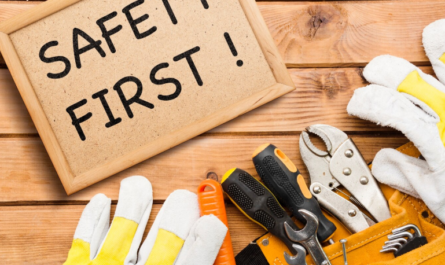🚧 Introduction: Why Safety Training Matters More Than Ever
In today’s high-risk, high-speed business environment, workplace safety is non-negotiable. Whether you’re in manufacturing, construction, healthcare, or even IT, having a well-structured safety training programme is crucial—not only for compliance but for saving lives.
A poorly trained workforce can lead to accidents, lawsuits, damaged reputations, and costly downtime. On the flip side, a robust safety training system can significantly improve morale, productivity, and long-term sustainability.
So, how do you go about designing and developing a safety training programme that actually works?
Let’s walk you through every essential step to build an impactful, modern, and effective safety training plan in 2025.
📋 Step 1: Conduct a Safety Needs Assessment
Before you build any training content, you need to understand your organization’s specific risks.
🔍 What to do:
- Identify job roles and associated hazards
- Review past incident reports and near-misses
- Analyze industry-specific regulations and legal requirements (like OSHA, ISO 45001, etc.)
- Survey employees and supervisors about knowledge gaps
🎯 Outcome:
A clear list of training needs, categorized by role, risk level, and urgency.
👉 WordPress SEO Tip: Use keywords like safety training needs analysis or workplace risk assessment here.
🧩 Step 2: Set SMART Training Objectives
Now that you know what to teach, it’s time to define learning objectives that are Specific, Measurable, Achievable, Relevant, and Time-bound (SMART).
Examples:
- “By the end of this module, forklift operators will demonstrate proper loading techniques with 100% compliance.”
- “New hires will complete fire safety training within 7 days of joining.”
Setting clear objectives ensures your training stays focused and result-driven.
👉 Pro Tip: Use action verbs like demonstrate, identify, apply, or evaluate when crafting learning goals.
🛠️ Step 3: Design the Training Programme Structure
Now comes the design phase, where you decide the delivery method, format, duration, and content types.
📚 Key Considerations:
- Format: Online, classroom, blended learning, simulations
- Duration: Short sessions for busy workers vs. comprehensive courses
- Mode: Interactive videos, quizzes, infographics, role-plays, case studies
- Customization: Tailored by department or job role
Popular Tools:
- Learning Management Systems (LMS) like TalentLMS, Moodle, or SAP Litmos
- Tools like Canva for designing training visuals
- Virtual Reality (VR) for immersive hazard simulations
👉 Include in WordPress: Use a bullet list for training components and embed a YouTube sample video if possible.
🧠 Step 4: Develop Engaging and Practical Content
Content is king—but engagement is emperor. Dry, jargon-heavy training modules won’t stick. Instead, focus on creating content that is:
- Visually appealing
- Interactive
- Real-life relevant
- Easily digestible
✅ Must-Have Topics in Any Safety Programme:
- Fire safety and emergency procedures
- First aid and CPR
- Personal protective equipment (PPE) usage
- Hazard communication
- Electrical and machinery safety
- Ergonomics
- Workplace violence prevention
👉 WordPress Tip: Use H3 tags for each training topic for SEO and better readability.
🧪 Step 5: Pilot Test the Training
Before rolling it out company-wide, test your training programme with a small group.
What to evaluate:
- Are the instructions clear?
- Is the content too long or too short?
- Are learners engaging or zoning out?
- Are assessments fair and effective?
Gather feedback and revise accordingly. This step ensures a smooth rollout and avoids wasting time and resources on ineffective content.
🚀 Step 6: Implement the Training Programme
Now, launch your training across the organization.
Launch Essentials:
- Communicate clearly with employees and supervisors
- Assign deadlines and completion timelines
- Track participation and completion through an LMS
- Schedule follow-ups and Q&A sessions
For WordPress blogs, this is a great place to embed a call-to-action (CTA) for readers to download a free safety checklist or training template.
🧾 Step 7: Assess and Evaluate Training Effectiveness
No training programme is complete without evaluation. You need to measure whether the training is actually making a difference.
Evaluation Methods:
- Quizzes and exams
- On-the-job observations
- Post-training surveys
- Incident reduction rates
- Feedback from safety officers
You can also apply the Kirkpatrick Model of training evaluation:
- Reaction – Did they like it?
- Learning – Did they learn it?
- Behavior – Did they apply it?
- Results – Did it improve safety?
👉 WordPress SEO idea: Link to a related article on “How to Measure Training Effectiveness Using the Kirkpatrick Model.”
🔄 Step 8: Update and Improve Continuously
Safety training is not a one-and-done task. Regulations change. Technology evolves. People forget.
How to stay updated:
- Schedule annual training refreshers
- Monitor legal and industry changes
- Use feedback from incidents or audits to improve training
Modern safety leaders treat training as an ongoing conversation, not a checkbox.
👥 Step 9: Create a Safety-First Culture
The best safety training programmes don’t just teach procedures—they build a culture where everyone takes ownership of safety.
How to foster a safety-first culture:
- Recognize and reward safe behavior
- Encourage open communication and near-miss reporting
- Involve employees in hazard identification
- Set a strong example through leadership
This cultural approach transforms safety from a rule to a shared value.
📌 Final Checklist: Your Safety Training Programme Toolkit
Here’s a quick rundown of what your safety training programme should include:
✅ Needs assessment
✅ SMART learning objectives
✅ Structured programme design
✅ Engaging content
✅ Pilot testing
✅ Full implementation
✅ Evaluation and metrics
✅ Continuous improvement
✅ Cultural integration
Save this checklist as a PDF or print it out—it’s your roadmap to safety training success in 2025.
📝 Conclusion: Train Smart, Stay Safe
Designing and developing a training programme for your safety department isn’t just a compliance task—it’s a strategic investment in your people and your business.
By following these nine steps, you’ll create a safety ecosystem that not only meets regulations but empowers your workforce, reduces risk, and drives performance.
Remember: a trained employee is a safe employee—and a safe employee is a productive one.
🔁 Related Articles
- Safety Management’s Role: The Unsung Hero Behind Every Successful Organization
- Safety Management and Its Responsibilities: Protecting People, Preventing Hazards, and Promoting a Culture of Care
- Benchmarking for Safety Performance: A Key to Continuous Improvement
💬 Join the Conversation
Have you recently developed a safety training programme? What challenges did you face? Let us know in the comments or share your insights with the community!
“Start Your Website Journey Today – Exclusive Hostinger Discounts!”

Turn Any Idea into Viral,
Jaw-Dropping AI Videos in Seconds!










